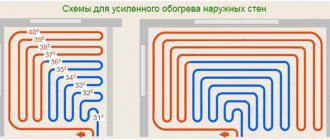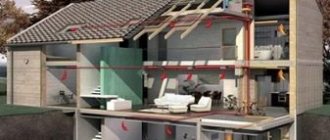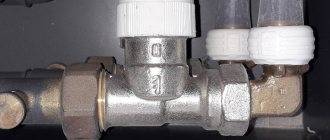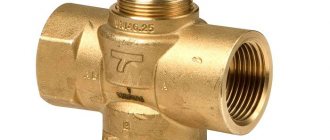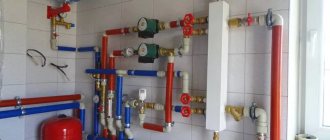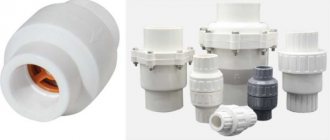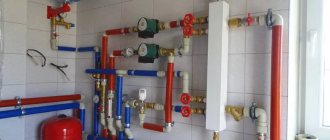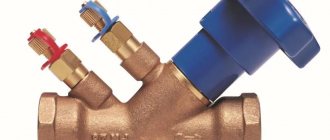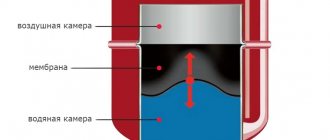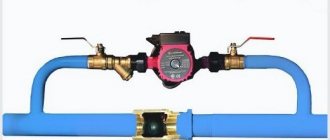Every year before the heating season, utility services notify citizens living in high-rise apartments that it is necessary to bleed air from the heating system. The reasons for the formation of air in the heating system are factors such as the release of hydrogen during chemical reactions, as well as repair work, as a result of which water is drained from the system. To remove air, special devices are used - air vents.
Air vents for heating systems are also called air release valves, without which it is impossible to ensure the normal functioning of the heating system.
The influence of air on the heating system
The functioning of the heating system is based on the circulation of heated water with the release of part of the heat into the radiators to heat the room. If air enters the internal part of the system (the process is called airing), a disruption in the circulation of the coolant occurs. The system responds to airing as follows:
- When the coolant circulates, noises are clearly audible, which not only creates discomfort for residents, but is also a symptom of pipeline vibration, as well as backlash in connections. In some cases, vibrations result in the destruction of welded joints with obvious unpleasant consequences.
- Air pockets form in the circuits. This happens especially often in non-residential premises where there is no regular temperature control. The result of traffic jams is defrosting the system.
- Deterioration of circulation or its complete cessation. Under conditions of slow circulation, the efficiency of the system decreases and fuel consumption increases.
- The development of corrosion processes as a consequence of air penetration into internal metal parts. The result of corrosion is a reduction in the operating life of equipment.
How does an automatic air vent work?
The automatic valve operates according to the following scheme:
- When the reservoir cavity is completely filled, the float is pressed up and the spring valve is closed.
- As a plug forms in the tank, the float lowers.
- The float presses on the spring, the valve opens, air escapes, and excess pressure arises.
- Water fills the cavity, presses the float, and closes the bypass valve.
The design ensures timely bleeding of air and prevents leakage of coolant liquid.
During the process of filling the circuit with coolant, air is continuously released, since the float is placed at the very bottom of the chamber. As soon as the cavity is filled completely, the float closes the valve and the release of air will stop. Some of the gas remains under the housing cap, but this factor does not affect the quality of the heating system.
Main types
Air bubbles contained in the coolant begin to accumulate in certain areas of the heating system and in the radiators. The bubble that appears continues to be replenished with new portions of air and forms a plug that blocks the movement of the coolant in this place. As a result, nearby heating radiators cool down. To remove air, 2 types of bleed valves are used:
- automatic air release valve;
- Mayevsky manual crane.
Mayevsky manual crane
The design of the Mayevsky valve is very simple to understand. At the ends of the housing with an external threaded connection ½″ or ¾″ there is a hole with a diameter of 2 mm. This section is covered with a screw with a cone-shaped tip. There is a small hole on the side of the faucet that is designed to release air.
The modernized air release valve has a rotating plastic sleeve, inside of which there is a channel for exhaust. Convenience is that the position of the reset hole can be adjusted by turning the plastic sleeve. A mechanical valve for bleeding air from the heating system works according to the following principle:
- When the heating is running, the shut-off screw is screwed in and the cone securely closes the hole.
- If it is necessary to get rid of the air lock, the screw is unscrewed several turns. Under the pressure of the water in the thermal system, the plug comes out through the hole, then passes into the drain channel and moves outward along it.
- First, clean air comes out, then along with the coolant. The screw is tightened when clean water begins to come out of the channel.
In this video you will learn the pros and cons of the air valve (air vent):
Automatic air vent
It is easy to understand that this valve operates without human intervention. The device has the form of a vertical brass barrel with a G ½″ threaded connection, where a plastic float is located, which is connected to a spring-loaded valve to remove the air lock. The operating principle of an automatic air valve for heating is as follows:
- When the heating system is running, the chamber in the housing is filled with water, which lifts the float upward. The spring-loaded valve is in the closed position.
- Taking into account the accumulation of air in the upper part of the valve, the water level decreases and the float lowers.
- When the level drops to its maximum, the mass of the float will completely compress the spring, thereby opening the valve. As a result, air begins to escape.
- Due to excessive pressure in the thermal system, the coolant will displace the air from the valve, water will take this place and bring the float back into working condition.
According to their design, automatic valves for venting air from the heating system can be with an angular or straight connection. Some manufacturers make the discharge hole from above, others - to the side. For the consumer, these differences do not play a significant role, but for an experienced plumber they can tell a lot. As practice has shown, equipment with side discharge is more reliable in operation than valves with top outlet.
The design of automatic valves is constantly being improved. Leading manufacturers provide these elements with various functions:
- Protection against water hammer using a special plate (installed at the entrance to the chamber).
- Installing a mini-valve into the radiator plug.
- Possibility to unscrew the air vent for repairs without emptying the heating system. This is achieved thanks to the presence of an automatic shut-off spring-loaded valve installed on the inlet fitting. If the plumber unscrews the element, the spring is aligned and the sealing washer blocks the passage.
Automatic air vent – operating principle, overview:
Device options
There are three types of automatic air vents: corner type, straight type and radiator type. External differences and scope of application do not in any way affect the operating principle of the devices. Let's look at the features of each modification.
Direct air vent
Direct air vent
The most common type is with a straight connection pipe. Installed at the highest points of the heating system, where air pockets most often form.
The direct automated air vent is part of the safety group of the heat generator, which is located on the pipe extending from it. An air vent is necessary here to remove air when filling the boiler tank with water. In case of carrying out maintenance work, the boiler tank can be disconnected from the heating system and emptied using an air vent.
Some types of circulation pumps also require the installation of an air vent in order to ensure uninterrupted operation. Pumping equipment transports only an incompressible medium, and if an air lock appears in the impeller, it may stop. This threat is controlled and prevented by the diverter.
Ball
Sewage flooding is especially likely in high-rise buildings, where several apartments are located on one vertical pipe. Even one plastic bag may be enough to clog the riser, and then yes, not finding its way, will rush back, splashing out of all the drain holes. This situation is especially likely in old houses, where the pipes are covered on the inside with thick crusts of deposits.
The risk of backflow of waste water is especially high in apartments on the ground floor. Often at night in such apartments it is necessary to plug the drains with rags, plugs and other improvised plugs. But if valves are installed on the first floors, water can break through on the second floor. Up to the third floors, the pressure is usually not enough, and if it is strong enough, it will simply destroy the blockage and the water will go into the pipe.
So, it’s worth installing a check valve if:
- Your apartment is located on the first or second floor.
- You live in an individual home: a cottage, a dacha, a private house.
- The house was built a long time ago and there has been no major repair of the sewer system or replacement of risers.
- According to neighbors, there are frequent cases of sewer blockages in the house.
In this case, the small costs of purchasing and installing protective devices will pay off handsomely, allowing you not to worry about sudden costs and hassle.
If your home has a common riser valve installed, it can reduce the risk of flooding. But in problem apartments it is better to install separate valves on each drain to be completely sure.
Device
In 2022, there are many options for such a unit. They differ in materials, sizes and shapes, locking methods and many other parameters. But all types of valves have the same purpose - to cut off sewer water in the pipe that rushes sharply in the opposite direction.
Almost any design has the following elements:
- The pipes through which drained water enters and leaves the valve.
- A handle that closes the valve forcibly. It can be used when cutting off drains at night, or when trying to unclog a sewer system.
- A removable cover that allows you to inspect the condition of the valve and, if necessary, clean its parts from contamination.
- Locking mechanism. A ball valve is a rubber ball, but membranes, flaps and other devices can also be used.
The valve will not work if the “input” and “output” are reversed. Typically, the direction of movement of the drains in the valve is shown by an arrow marked on the body. Take this into account during installation!
Main types
First of all, valves vary in diameter. In the standards for sewer installation, left over from Soviet times, a diameter of 110 mm is established for risers, and all other pipes have a diameter of 50 mm. Today, non-standard options have appeared, for example, with a diameter of 75 mm, but they are significantly less widespread.
Various materials are used to make shut-off devices. They can be either metal (bronze, brass, stainless or carbon steel) or polymer (PVC, polyethylene). Each option has its own advantages and disadvantages:
- Metal products are significantly more expensive. They are durable, but require attention to their condition and periodic maintenance.
- Plastic valves are cheaper. They practically do not corrode. But the mechanical strength of such structures is less.
The design of check (or fan) valves also differs. Here are the most common options:
- The ball valve has a very simple design: a rubber ball is loosely located in the pipe, the diameter of which is slightly larger than the overall diameter of the pipe. When the liquid moves in the forward direction, the ball moves into a special chamber, and when it moves in the opposite direction, the ball, picked up by water, tightly plugs the neck of the pipe. Thanks to such a simple design, there is simply nothing to break in this device.
- Wafer device. The most compact option. This valve is convenient for installation in confined spaces. But if it fails, you will have to disassemble part of the system in order to repair or replace the faulty unit.
- Lift and rotary valves have spring-loaded flaps in their design. Such devices are relatively large, heavy and not cheap. The advantage is the ability to easily disassemble for cleaning, adjustment and minor repairs.
The choice of a specific type of device depends on the budget allocated for repairs, installation location, type of pipe and existing conditions.
How to properly install an air valve for sewerage, read the article: here
Installation recommendations
Regardless of the type of automatic air intake for heating, you need to ensure that the exhaust cap faces up during installation. Bleed valves in systems are usually installed after ball valves or shut-off valves. An exception to the rule is the boiler safety group: secondary intermediate fittings are not used in this case.
Thanks to the shut-off check valve, it becomes possible to carry out maintenance or replacement of the air vent without emptying the entire heating system. Therefore, having such a device is very convenient. Only wrenches are suitable for installing an automatic bleeder: they, unlike adjustable ones, allow you to measure the effort required to screw the fastener. During installation work, it is not recommended to hold the device by the body to avoid damage. For these purposes, the design provides a hexagon at the bottom of the cylindrical chamber.
How to install an air vent with your own hands (instructions)
There are several important features in the design of a self-acting air vent. It needs to be installed only vertically, the valve hole must point upward, otherwise it simply will not work.
- Before installing it, a tee with the appropriate thread diameter is screwed into the pipeline - 1/2 inch.
- In polypropylene pipes, a tee with a metal thread is soldered.
- A separate outlet is provided on the surface of the safety group.
Causes of air
The logical question is: how does air get into the heating system if it is completely sealed?
There can be many reasons for this phenomenon:
- High blood pressure. Water contains not only magnesium and calcium, but also oxygen. The volume of oxygen depends on the pressure level in the system. As pressure increases, the concentration of oxygen in water increases.
- Violation of requirements for pipe slopes during installation work.
- Incorrect filling of the pipeline, leading to air congestion. Water should be supplied slowly while air is pumped out of the batteries, right? otherwise, the formation of bubbles is inevitable, which causes airing of the heating system. The general rule is: the more branches a system has, the slower its filling should occur.
- Diffusion. This phenomenon is a process during which the ability of molecules of one substance to penetrate between the molecules of another is realized. In the described case, we mean the penetration of oxygen molecules between the molecules of polypropylene or polyethylene. To prevent diffusion, special coatings are applied to the pipe material.
- Insufficient connection density between system elements.
- Faulty or missing air vents.
- Carrying out repair work during which depressurization occurred.
- Corrosive processes leading to violation of the tightness of equipment.
The above factors do not exhaust the reasons that cause air in the heating system, but they are the most common.
Differences in the design of air vents
The design of various air vents is not always identical; according to this criterion, they are also divided into types. Pay special attention to this when choosing. Here are the common types of air vents for heating (by design):
- Direct.
- Angular.
- Having an unusual shape.
Angle air vent
It is also worth mentioning that the design may differ due to a certain operating principle. For example, the most common are needle and ball devices. Pay attention to this when choosing!
What is an air valve?
The air valve for heating is a sealed cone-shaped or cylindrical body made of brass. Inside it is a hollow float made of Teflon or polypropylene. This float is connected by a lever to the drain valve, which is equipped with a locking plug. This plug prevents coolant leakage if the device breaks down.
Now, once and for all, without any registrations or SMS, you can download 1xBet for Android for free by clicking on the active link and continue to enjoy the game and place bets on your favorite team in a convenient mobile application.
Air vents for heating systems come in three types:
- Direct devices of traditional type. They are mounted only vertically.
- Corner type devices that are installed at right angles. They are mounted on radiators instead of Mayevsky taps or in the event that a direct type of air vent cannot be installed.
- Special models for installation on radiators.
According to the principle of operation, the air vent can be manual (Maevsky tap) or automatic. The last variety is the float-type devices described above.
Operating principle of manual valve
Let's figure out how a manual air bleeder for a heating system works. To understand the structure of this type, you need to look at the drawing of the Mayevsky crane. At the end of the brass body with external thread there is a hole with a diameter of 2 mm. It is covered by a screw with a cone tip. On the side of the same body there is a hole of a smaller diameter, which is used to bleed air.
The operating principle of a manual air vent is as follows:
- In operating mode of the heating circuit, the shut-off screw is tightly tightened. The outlet is hermetically sealed with a cone.
- To release the air lock, the screw is unscrewed a couple of turns. As a result of coolant pressure, air begins to escape through a small hole, then enters the outlet channel and is discharged outside.
- Moreover, at first only air comes out of the hole, then an admixture of water appears. The tap must be closed when only a stream of water flows from the hole.
Because there are no moving parts to clog, rust, or wear out, a manual air vent is a reliable, trouble-free device. This valve is installed only on radiators.
Manual type valves are divided into the following types according to the method of unscrewing:
- a metal or plastic handle is used for opening;
- More often you can find a slot for a screwdriver with a flat working blade;
- To unscrew it with a special key, there is a screw with a tetrahedral tip.
Operating principle of automatic valve
The automatic air collector for the heating system works without human intervention. It is essentially a vertical brass cylinder with threads and a plastic float inside. The float is connected by means of a lever to the air release valve pressed by a spring. This valve is built into the lid.
The operating principle of an automatic air vent in a heating system is as follows:
- When the heating system is operating, the internal chamber of the device is filled with water, which presses the float up. As a result, the air valve is pressed by a spring and tightly closed.
- When air accumulates in the upper part of the chamber, the level of the coolant decreases, which causes the float to lower.
- When the liquid level drops to a critical value under the weight of the float, the spring compresses and opens the valve. As a result, the air begins to bleed out.
- Due to the increased coolant pressure in the system, all air is displaced from the chamber of the device. The liquid takes the place of the displaced air and causes the float to rise, which pushes the valve up and tightly closes the hole.
While the network is being filled with coolant, air pockets are constantly being bled off, since the float lies at the bottom of the container. When water fills the chamber, a spring mechanism raises the valve. As a result, the bleeding process stops. However, some oxygen remains in the housing under the cover, but this in no way affects the operation of the heating circuit.
Automatic devices come with angular and direct connection. The latter type discharges vertically, and the first - to the side. The corner version is valued for its reliability, but collects air bubbles worse.
Where should air vents for heating systems be installed correctly?
When installing a heating system, installing air vents is a mandatory procedure; to determine the required quantity, you need to know where to place these devices. Air vents are recommended to be located in the following places:
- The highest points of the system. If during installation the pipeline rises upward, bypassing any obstacle, and then descends down to the heat exchangers, an automatic air vent for the heating system should be installed on top. This will prevent airing due to the fact that light air always rises and accumulates in the pipeline on the upper floor.
Rice. 9 Types of automatic air vents
- Heating radiators. Radiator heat exchangers have a complex shape, including a large number of sections - this creates convenient cavities for air accumulation. Therefore, Mayevsky outlet valves are always used in radiators; in an individual heating circuit, they are installed on each radiator, regardless of the connection diagram (one-pipe, two-pipe, bottom, side, diagonal). Radiator manual models of exhaust valves, unlike automatic ones, are small in size, less expensive, fit aesthetically into the radiator contour, and therefore are installed on batteries in the vast majority of cases by the manufacturer and, if necessary, by home owners.
- Heated towel rails. Industrially produced heated towel rails of the complex “ladder” shape, popular in everyday life, are always equipped with an air vent with a straight pipe located in its upper part. It is more convenient if the heated towel rail is equipped with an automatic air vent for the following reasons: the screw located at the top of the manual model is inconvenient to tighten, in residential buildings there may be periodic lack of water and manual adjustment becomes troublesome, in addition, the duct protruding from the side spoils the aesthetic appearance of the heater.
- U-shaped bends and bypasses. Any section of a pipeline with an upward-facing loop collects air; if a shut-off valve is used to turn off the loop, it is installed at the highest point, using a model with a built-in automatic Mayevsky valve (naturally, the air vent at the top can be installed separately from the valve).
- Boiler piping system. It is also recommended to equip the boiler piping with a valve to ensure safe operation of the heating equipment in the event of airing in the main line.
- Hydroshooters. It is not so often that in household heating systems they use hydraulic arrows, to which circulation pumps, radiator and heated floor collectors are connected - if the device is located vertically, an automatic air bleeder is screwed into its upper part.
- Collectors. When installing multi-circuit heated floors, manifolds with combs are used, to which the pipeline of various circuits is connected. The collectors are located above the level of the water floors and are always equipped with automatic air vents, which are installed in their housing by the manufacturer; the system includes two devices for the supply and return lines.
Rice. 10 Manual and automatic air vents for heating systems - location diagram
Types of automatic air vents
Automatic air vents are available in the following types:
The straight lines that we met in the very first pictures, I’ll show them again:
Angular ones, which are often installed on radiators instead of the Mayevsky tap:
Radiator plugs having the same thread as radiator plugs:
As you know, Mayevsky valves are designed to bleed air from the system through the radiator. This bleeding is performed manually as an air plug forms in the radiator, which is easy to determine by touching the radiator with your hand... Installing a radiator air vent frees you from such work, since the air will be removed automatically.
However, no matter what the air vent looks like, they work on the same principle.
Device
The design of the automatic air vent is enclosed in a metal case (bronze, brass, stainless steel), at the bottom of which there is a connecting pipe. The body is sealed and can be cylindrical or cone-shaped. In our country, we have established the production of air vents with external connecting threads 1/2” (DN15) and ¾” (DN 20), in rare cases you can find 3/8”. Inside the barrel there is a float made of polymer material or stainless steel. Through the rocker arm (lever), the float is combined with a spool (spring-loaded drain valve), on the fitting of which a locking cap is placed. In general, the part looks like this:
Purpose and types of air vents
Air vents are used to remove accumulated air from the heating system. They are divided into manual ones, opened by service personnel, and automatic ones, which do not require human intervention. The simplest device is a faucet. A more complex device is an air collector. Modern devices - automatic air valve for heating. Special devices are used in individual elements of the heating system. The most common is the “Maevsky tap”.
Manual air vents
When filling the heating system, the coolant, coming under pressure, must displace all the gas. To do this, at the highest point of the system, a valve is installed to bleed air from the heating system. In order for filling to occur in a relatively short time, the capacity of the crane must ensure a free exit. Therefore, taps with a diameter of at least 15 mm, and sometimes more, are installed. After the system is filled, the tap is closed.
In the first days of heating operation, gases are very actively released from the coolant and accumulate. Therefore, maintenance personnel daily, and sometimes 2 times a day, bypass all the air bleed valves and release it. This requires a lot of mechanics and time.
To reduce labor costs, they began to install small tanks for collecting air, which were called air collectors. Now the bypass could be performed much less frequently, but it was still required.
In modern houses, apartment-by-apartment heating distribution with a lower piping arrangement is increasingly being used. The use of such a heating system provides a number of advantages: savings in materials during installation, apartment-by-apartment heat metering, apartment-by-apartment temperature control, up to complete shutdown, and improves the design of the room. But some problems also arise. When filling such a heating system, the air in the batteries cannot be forced out of it. Since the heating device is located above the pipeline.
Schemes of a single-pipe heating system in a private house Single-pipe heating system of a private house with bottom wiring: diagram Comfort in the house is not only a beautiful environment, correctly selected interior items, but also warmth, especially in the winter cold. Heating must be provided constantly, which creates a comfortable…
Therefore, to bleed air, all modern heating devices are equipped with an air vent valve for removing gases, small in size, its name is “Mayevsky tap”. By the name of the inventor of this crane. These taps can only be opened and closed manually. The principle of the device is simple. A screw is screwed into the plug, pointed at the end into a cone. With two or three revolutions, the cone moves away from the hole and slowly releases air. When water drops appear, the screw is screwed back in and closes the hole.
Automatic air vents
Nowadays, all production processes are being automated to reduce costs and improve quality. And instead of air collectors, they came up with an automatic air vent valve. Which will independently bleed air from the heating system.
The device of an automatic air valve for heating resembles a float in a car carburetor.
When air accumulates, the float lowers. A needle attached to the float axis opens a hole through which gases escape. Water filling the float chamber raises the float and the needle closes the hole. Some automatic air valves are more complex, but the principle is the same. To check the operation of the valve, many are equipped with a button with a rod, which can be used to manually lower the float and check for the presence of air. At the same time, tear off the tip of the needle from the seat of the hole if sticking occurs due to the deposition of salts present in the water. Date: September 25, 2022
Mechanical
The body of a manual release is usually made of brass, has a simple design and small size. The main part of the entire Mayevsky faucet is a needle-type shut-off valve. To engage it and expel air, you need to turn the screw counterclockwise one turn with a special key, screwdriver or hand, depending on the model of the device. The needle opens a hole and gases escape through it. At this point, a faint hissing sound will be heard. As soon as all the air has escaped, coolant begins to flow out through the hole. After this, you need to tighten the screw all the way.
Attention! If the heating system is forced, then the circulation pumps should be turned off before bleeding air.
The only drawback of mechanical devices is that all operations with them have to be carried out manually.
